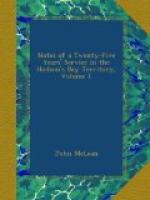Such parts of the district as are not in the immediate vicinity of the regions of eternal snow, yield a variety of wild fruit, grateful to the palate, wholesome, and nutritious. Of these, the Indian pear is the most abundant, and most sought after, both by natives and whites; when fully ripe, it is of a black colour, with somewhat of a reddish tinge, pear-shaped, and very sweet to the taste. The natives dry them in the sun, and afterwards bake them into cakes, which are said to be delicious; for my own part, having seen the process of manufacturing them, I could not overcome my prejudices so far as to partake of a delicacy in whose composition filth formed so considerable an ingredient. When dried, the cakes are placed in wooden vessels to receive the juice of green fruit, which is expressed by placing weights upon it, in wooden troughs, from which spouts of bark draw off the liquid into the vessels containing the dry fruit; this being thoroughly saturated, is again bruised with the unclean hand, then re-formed into cakes, and dried again; and these processes are repeated alternately, until the cakes suit the taste of the maker. Blue berries are plentiful in some parts of the district; there is a peculiar variety of them, which I preferred to any fruit I ever tasted; it is about the size of a musket-ball, of a purple colour, translucid, and in its taste sweet and acid are deliciously blended.
The district is still rich in fur-bearing animals, especially beavers and martens, which are likely to continue numerous for many years to come, as they find a safe retreat among the fastnesses of the Rocky Mountains, where they multiply undisturbed. This is the great beaver nursery, which continues to replace the numbers destroyed in the more exposed situations; there is, nevertheless, a sensible decrease in the returns of the fur since the introduction of steel traps among the natives: there are also otters, musk-rats, minxes, and lynxes. Of the larger quadrupeds bears only are numerous, and in all their varieties, grizzled, black, brown, and chocolate: numbers of them are taken by the natives in wooden traps. A chance moose or reindeer is sometimes found. The mountain sheep generally keeps aloft in the most inaccessible parts of the mountains, and is seldom “bagged” by a Carrier, but often by the Tsekanies. I have before observed that rabbits sometimes abound. Another small animal, whose flesh is delicious in season, the marmot, is found in great numbers. In the neighbourhood of Fort Alexandria, the jumping deer, or chevreuil, is abundant. To these add dog and horse flesh, and you have all the varieties of animal food the country affords to its inhabitants, civilized or savage.
A most destructive little animal, the wood-rat, infests the country, and generally nestles in the crevices of the rocks, but prefers still more human habitations; they domicile under the floors of out-buildings, and not content with this, force their way into the inside, where they destroy and carry off every thing they can; nor is there any way of securing the property in the stores from their depredations but by placing it in strong boxes. When fairly located, it is almost impossible to root them out. They are of a grey colour, and of nearly the size and form of the common rat, but the tail resembles that of the ground squirrel.




